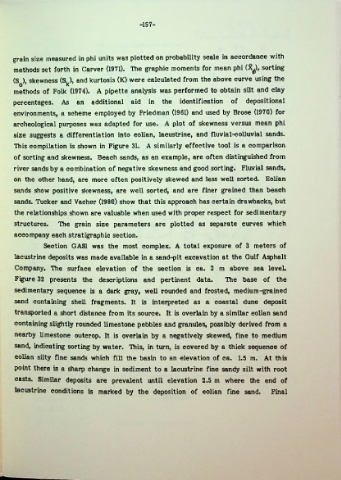Page 181 - Life & Land Use on the Bahrain Islands (Curtis E Larsen)
P. 181
-157-
grain size measured in phi units was plotted on probability scale in accordance with
methods set forth in Carver (1971). The graphic moments for mean phi (X^), sorting
(SQ), skewness (Sk), and kurtosis (K) were calculated from the above curve using the
methods of Folk (1974). A pipette analysis was performed to obtain silt and clay
percentages. As an additional aid in the identification of depositional
environments, a scheme employed by Friedman (1961) and used by Brose (1970) for
archeological purposes was adapted for use. A plot of skewness versus mean phi
size suggests a differentiation into eolian, lacustrine, and fluvial-colluvial sands.
TTiis compilation is shown in Figure 31. A similarly effective tool is a comparison
of sorting and skewness. Beach sands, as an example, are often distinguished from
river sands by a combination of negative skewness and good sorting. Fluvial sands,
on the other hand, are more often positively skewed and less well sorted. Eolian
sands show positive skewness, are well sorted, and are finer grained than beach
sands. Tucker and Vacher (1980) show that this approach has certain drawbacks, but
the relationships shown are valuable when used with proper respect for sedimentary
structures. The grain size parameters are plotted as separate curves which
accompany each stratigraphic section.
Section GAS1 was the most complex. A total exposure of 3 meters of
lacustrine deposits was made available in a sand-pit excavation at the Gulf Asphalt
Company. The surface elevation of the section is ca. 3 m above sea level.
Figure 32 presents the descriptions and pertinent data, The base of the
sedimentary sequence is a dark gray, well rounded and frosted, medium-grained
sand containing shell fragments. It is interpreted as a coastal dune deposit
transported a short distance from its source. It is overlain by a similar eolian sand
containing slightly rounded limestone pebbles and granules, possibly derived from a
nearby limestone outcrop. It is overlain by a negatively skewed, fine to medium
sand, indicating sorting by water. TTiis, in turn, is covered by a thick sequence of
eolian silty fine sands which fill the basin to an elevation of ca. 1.5 m. At this
point there is a sharp change in sediment to a lacustrine fine sandy silt with root
casts. Similar deposits are prevalent until elevation 2.5 m where the end of
lacustrine conditions is marked by the deposition of eolian fine sand. Final

